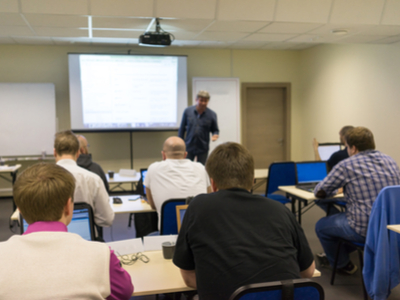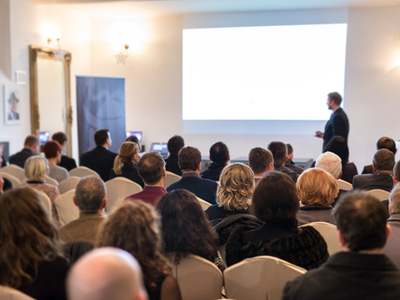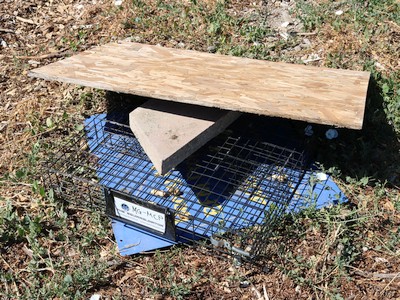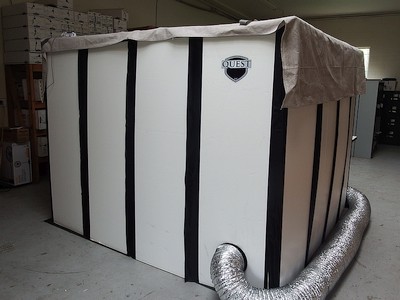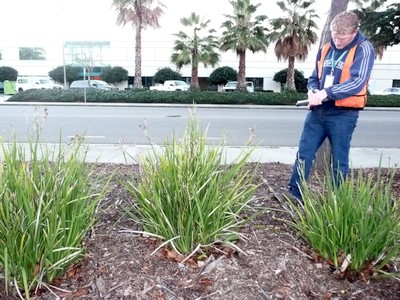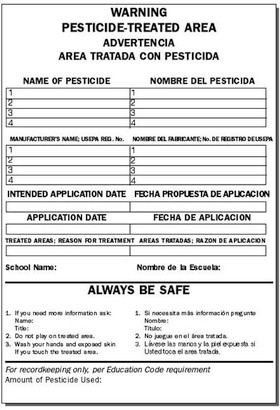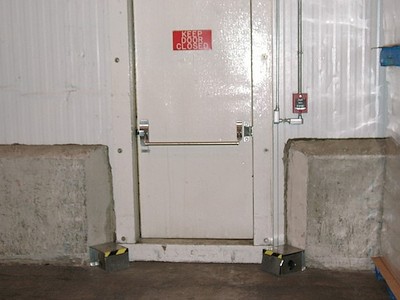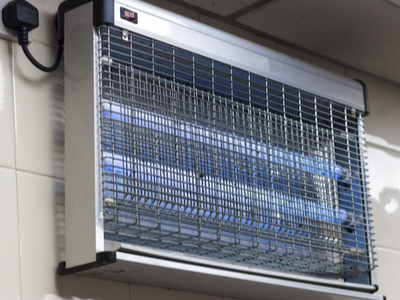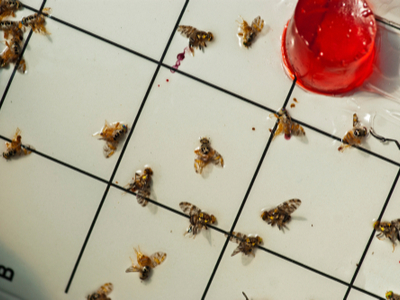Santa Clara County's IPM Administrative Guidelines & Procedures
The following chapters of Santa Clara County IPM program administrative guidelines and procedures will provide you an in-depth understanding of the management tools, roles and responsibilities necessary to implement a successful IPM program for a multi-jurisdictional public agency.
Broadly defined, a pesticide is any agent used to kill or control undesired insects, weeds, rodents, fungi, bacteria, or other organisms. Pesticides are classified according to their function: insecticides control insects; rodenticides control rodents; herbicides control weeds; and fungicides control fungi, mold and mildew.
Pesticides have enabled growers to produce some crops profitably in otherwise unsuitable locations, extend growing seasons, maintain product quality and extend shelf life. They enabled us to maintain reliable and safe rights-of-way, major conduits for the flow of goods and services vital to our economy. They also protected us from vector-borne diseases and other emergency situations.
Nevertheless, these chemicals also pose some risks if used improperly or too frequently. Several problems and limitations have become apparent by relying solely on pesticides to control pests. Some of the problems include: pesticide resistance, increased costs, toxicity to wildlife, toxicity to beneficial natural enemies of pests, concerns about human health and safety, ground water contamination, and overall environmental quality. Pesticide exposure from drift to non-target areas; contamination of ground and surface waters and residues on food have also become topics of concern to the general public.
The ideal pesticide is one that will act rapidly on pests, yet be completely harmless to people, domestic animals, wildlife, and other aspects of the environment. Its residues would last only as long as necessary to create the desired effect, usually for very short periods. It would also be inexpensive and readily available in necessary quantities, chemically stable (before application), non-flammable, and otherwise, safe to use around homes or industrial sites. It would be easily prepared and applied, non-corrosive, and non-staining, and it would have no undesirable odor. (Truman's Scientific Guide to Pest Control Operations, ISBN 0-929870-45-X). Unfortunately, no such ideal pesticide exists!
The control of pests in an urban environment has historically meant using a chemical pesticide to reduce pest numbers once an outbreak has occurred. There has been a major mind shift philosophically and practically, to the concept of pest management. The transformation utilizes balanced approach of physical, cultural, biological, and chemical measures, with primary focus on environmentally compatible, economically feasible approach to manage pest populations under threshold or acceptable levels.
The Santa Clara County IPM program took a cautious approach by restricting use of certain categories of pesticides. All pesticide currently in use or intended to be used by user departments will undergo the screening process based on set criteria. The final outcome of the screening resulted in the Approved List of Pesticides. (Ref: Santa Clara County IPM Ordinance No. NS-517.70, Section 28-5(a).) Since no ideal pesticide exists, these pesticides will only be used as a last resort.
The County has completed and compiled an initial review of approximately 300+ pesticide products. This was conducted in consultation with Dr. Lois Levitan at Department of Communication and Center for the Environment, Cornell University, NY. The contracted work was completed with the release of the Approved List of Pesticides.
For additional information on Pesticide Risk Analysis, click on the following links:
- Pesticide Risk Assessment
- Pesticide Risk Indicators Resources:
Each department IPM coordinator should notify the County IPM manager for necessary approval prior to opting for pesticide use (including pesticides on the approved list), unless an approval has been granted for extended periods of use. Use the prescribed form Request for Pesticide Use Exemption for such requests. The County IPM manager will work with the requesting user department to determine the necessity of pesticide usage and related non-chemical alternatives, to achieve overall pesticide use reduction.
Should a department coordinator decide to use a pesticide or purchase one, the department (through their Department IPM coordinator) or property management representative should submit an application for exemption on behalf of the contractor to the County IPM manager.
Review of the approved pesticide list is a continuous process based on data availability from a variety of sources. As new data is made available, screening processes will reinforce list objectives. Department IPM coordinators or contractors should submit their request to the County IPM manager in writing at [email protected].
The County IPM manager will continue to review additional products based on objective and subjective criteria as set forth. Please note that if additional consulting is required from a subject matter specialist, there may be a fee associated with new product review. The requesting department or contractor will be asked to bear the consulting charges if there are any.
Related Links
- Minimum Risk Pesticides (25b list) and Permitted Inert (4A) List
- A Method to Measure the Environmental Impact of Pesticides, Department of Communication, Cornell University
- Approved List: Santa Clara County IPM Ordinance No. NS-517.70, Section 28-5(a)
- Pesticides, Risks & Perception
Attachments
- Approved List - Selection Criteria Matrix
- Form - Request for Pesticide Use Exemption
- Approved List of Pesticide April 13, 2004
- Approved List of Pesticide by Product
- Approved List of Pesticide by Active Ingredient
- Approved List of Pesticide by Type of Pesticide
- IPM Guidance Manual for the Facility Managers & Building Occupants
- Approved List - Decision Rule 4
- Approved List - Decision Rule 5, 6
- Approved List - US EPA Toxicity Categories
- Criteria for Selecting Pest Control Products & Methods
A presentation given to SCC County IPM-TAG by Dr. Lois Levitan, Program Leader, Pesticide Environmental Risk Analysis Program, Department of Communication, Cornell University. - Assessing Impacts, Risks and Consequences of Pest Management
A presentation given to SCC County IPM-TAG by Dr. Lois Levitan, Program Leader, Pesticide Environmental Risk Analysis Program, Department of Communication, Cornell University. - Approved List - Decision Rule 1, 2, 3
The central lesson of urban IPM project implementation over the past decade is that the complex ecological and social context of IPM argues for a sustained effort combining elements of technological development, education, local organization, alliance building and lobbying.
Scientific excellence and adherence to ecological principles provide a strong technical basis for IPM development, and the application of participatory, non-formal adult education methods represent a real advance over models based on information dissemination and the delivery of simple messages. But these in themselves are not enough.
The long-term development of a sustainable IPM program also requires strong leadership and cooperation among user groups and the linkages between these groups and the wider community. The interactions of the people involved in a pest management system are the key to the success or failure of the program. When the respective roles of all the people in the pest management system are identified and agreed upon, and when these people communicate well with each other, effective and less expensive protection of the site and the people can be achieved with fewer risks.
Training is often identified as a major need or bottleneck in IPM projects, but uptake of lessons learned is often rather limited for various reasons. It can be argued that in some contexts, urban IPM requires a generally knowledge-intensive approach.
From this perspective, Santa Clara County's IPM trainings are not an end in themselves, but rather a good starting point for the development of a sustainable awareness among the public agency's user groups and the public at-large, enabling participants to design, implement and manage pest management plans beyond pesticides.
Training all employees on the basics of the County IPM policy, their department's IPM program, specific maintenance standards and IPM strategies will help ensure comprehension and consistency. Implementing the IPM approach from design through daily maintenance will eliminate unnecessary applications of chemicals. In addition, full implementation of a well-understood IPM approach will create a more efficient and safer environment, saving time and money and increasing worker safety.
All staff associated with the planning, design, construction, and maintenance of open space, parklands, roads, rights-of-way, parking lots, landscaped facilities and other areas where pests may need to be controlled should receive an orientation to the County IPM ordinance, their own department's specific IPM program, and these guidelines.
Department IPM coordinators, management groups, facility managers, procurement managers, policy analysts, public & environmental health managers, occupational safety managers, pest control contractors, gardeners and other ground maintenance workers for vegetation and/or other pest management activities should receive subject matter specific training on:
- An IPM overview, including: identification and life cycles of typical pests, weeds and beneficial insects; determining pest threshold levels for different types of landscapes and facilities; and pest monitoring techniques
- Noxious weed and other public-health pest identification, control, and regulations
- Pesticide laws and safety
- Specific best management practices as appropriate
- Pollution prevention, source control, hazardous material and waste management, green building concepts, eco-systems, watershed conservation, structural and landscape planning, etc
- Budget preparation
To reduce the potential for pesticide pollution from run-off and to conserve water, staff responsible for maintaining and scheduling irrigation systems should receive training on:
- Irrigation system maintenance and irrigation audits
- Scheduling based on evapotranspiration (ET) and seasonal fluctuations
- Backflow prevention
To the extent practical, IPM training should be shared across departments within Santa Clara County. This will minimize training costs and maximize outreach. The County IPM manager is currently planning development of interactive (subject matter specific) training modules. Some of these modules will also have on-the-job or field training components. As collaborative funding or grants are made available, these modules will be developed and posted on the website. Some of the subjects are as follows:
- "I am the County IPM Guard" - An Administrative Training for Department IPM Coordinators, Facility Managers, Procurement Managers and Policy Makers
- "My Contribution to The Healthy Environment" - An IPM Awareness Training for Santa Clara County Employees (Sanitation, Housekeeping and Maintenance Awareness training)
- "Sanitation, Maintenance and Housekeeping - Role of Facility Managers and Building Occupants in Preventing Pest Problems" - This training is in a movie format a collaborative effort of the County IPM Program and Orkin Exterminating Inc. The movie is available in VHS and DVD format, accompanied with "IPM Guidance Manual for the Facility Managers." The training through this media is capable of reaching all 16,000 county employees. We are also planning to disseminate the same to other interested public agencies and the pest control industry.
- "Kindergarten to K-12" - IPM Grass Root Campaign
- "The Bug that does not Bug Anymore" - Bug Safari
- "Rights-of-Way Pesticide Applicator Training" - Santa Clara County IPM Program has adopted this training manual as part of "SCC Annual Rights-of-way Pesticide Applicator Training". For more information please contact the County IPM Manager- [email protected]
- "Meeting the Experts" - Technical Training for Pest Managers, Subject matter specific training for various pest management projects
- "Reducing Risk Through Pesticide Safety and Education" - A training video designed (by UC Pesticide Education Program) for pesticide applicators to minimize self and environmental exposure to pesticides: The Pesticide Education Program strives to educate all pesticide applicators and users across the Santa Clara County about pest management alternatives, including the safe, proper, and legal use of pesticides. The program promotes responsible decision-making, which will protect pesticide users, public health, plant and animal health, and the environment. (The 113-page instructor's manual (PDF 2782K) is designed to be used with this video. Copies of this public-domain video are available from each state pesticide regulatory agency and Cooperative Extension Service pesticide applicator training coordinators). This training video is currently in use by SCC IPM Program as part of "Annual Pesticide Applicator Safety Education (IPM-PASE)" for pest control license holders, pest control maintenance workers and management staff in Department of Roads & Airport, FAF custodial and grounds staff and Department of Parks & Recreation. The California Department of Pesticide Regulation - Pest Management and Licensing branch has assigned 7 hours of continuing education units (CEU) to SCC IPM-PASE training. The training also meets State-mandated training requirements. For more information please contact the County IPM manager - [email protected].
- "Regional IPM Conference" and "Regional IPM Resource Manual" - Lack of training is often cited as an obstacle to the wider adoption of IPM methods, where each individual has to understand their role and participates to promote pest prevention and minimize pesticide use. Establishment of a collaborative IPM training program and conference, inclusive of several public agencies, organizations and industry has been a long-term goal of the program. A collaborative approach among participating public agencies in the Bay Area is designed to enable participants to develop and implement pest management plans beyond pesticide applications in their respective jurisdictions and to provide public education and outreach at a broader horizon. Santa Clara County has taken a leadership role in forming the IPM Regional Alliance. The first ever-Regional IPM Conference was hosted by Santa Clara County held on June 7, 2004 at the 70 West Hedding Street, San Jose, CA. The County IPM program was also successful in compiling and editing the first "Regional IPM Resource Manual". Approximately five hundred (500) copies were developed and distributed to the participants and other interested parties. Bio-Integral Resource Center, a non-profit organization and the co-author of the "Regional IPM Resource Manual", has requested to distribute this version through their IPM publication department. The proceeds will help their organization to further assist in improving and updating the manual as and when needed.
- "Precautionary Principles for Pollution Prevention" - A training module designed for policy makers and executive management, this training module provides an in-depth look on understanding environmental policy development and management, precautionary principles towards environmental stewardship, budget preparation, program/portfolio consolidation, grant and fund management, environmentally preferable purchasing, green building concepts, organic gardening, resource conservation, etc.
To effectively solve the pest issues of the managers, gardeners, maintenance personnel, and pest control contractors in each department, hands-on research is coupled with relevant, "real-world" use cases. Field trials and demonstrations are used to evaluate reduced-risk chemicals and alternative strategies. If they are proven effective and sustainable, these alternative methods are adopted on a wide scale and become an integral part of pest management practices, resulting in reduced use or elimination of use. Some examples are as follows:
- Aquatic weed control using mechanical harvesters
- Argentine ant control through precision baiting, physical alteration and tenant awareness
- Averting herbicide application in turf through field scouting and decision-making process
- Biological control of algae in lakes and ponds and rejuvenating water body using aerators
- Bird exclusion at correctional facilities
- Ground squirrel control at animal shelters
- Ground squirrel control at correctional facilities
- Dry wood termite control: Inspection leading to decisions about fumigant use or non-chemical approach
- Rat control at animal shelters
- Optimizing turf and landscape maintenance protocols and plant health care
- Gopher control at regional airports
- Rights-of-way vegetation management using hydro mechanical obliteration, hydro seeding and hydro mulching technology
- Rights-of-way vegetation management incorporating improvements in road design through poly pavement and weed mats
- Total vegetation control on roads (Rights of Way) - A decision making process
- Total vegetation control: using radiant heat and torches
- Total vegetation control: using rubber, wood mulch, weed fabrics
- Total vegetation control: using solarization
- Total vegetation control: using steam - Waipuna technology
- Total vegetation control: using organic herbicides
- Vermin proofing structures
- Yellow Jacket abatement, trapping and control in regional parks
Record keeping is an important element of any IPM program. It should be emphasized that record keeping need not be burdensome. Simple field notebooks or logs entered electronically in a central database can easily cover most records kept. The goal being that follow-up evaluations to determine what worked or didn't work, and what to do differently in the future, will be productive. The Santa Clara IPM-Pesticide Use Reporting System (IPM-PURS) which is currently under development will assist the departments to get critical analysis of their future IPM project needs.
The following are examples of records that should be maintained as part of a Department IPM Program:
Department IPM Plan
The written IPM plan kept with department IPM coordinators. The plan should be updated periodically, at least annually, as described under department IPM plan.
Department IPM Logbook
Each department that uses pesticides shall be required to keep records of pest management activities, including information about demonstration sites and exemptions. This information shall be placed in a centralized record, an IPM Logbook, or electronic equivalent (once available) in each occupied building for each department, kept in accessible locations in the coordinator's office or in front reception (whichever is more convenient and accessible for review). Call the county IPM coordinator to order additional copies of logbooks as required.
At least once per quarter, the department IPM coordinator should review logbook observations with facility management, as well as to make recommendations and draw action plans as needed. Every pest management activity such as, pesticide application, trapping or inspection shall be recorded and, when applicable, include at least the following information:
- Target pest and extent of problem
- Product name, active ingredients, EPA Registration number, formulation
- Quantity of pesticide used
- Site of pesticide application
- Date of pesticide application
- Name of person conducting pest management activity
- Application equipment number, if applicable
- Prevention and other non-chemical methods of control recommended or used
- Evaluation of effectiveness
The departmental IPM coordinator shall also maintain the following:
- A complete record of all pesticide use
- A copy of the labels and material safety data sheets (MSDS) of all pesticides used
- A yearly summary of all pest management records required in section B28-8 (a) and (b) of the County IPM Ordinance. Data shall be to be compiled into an annual department IPM report to be submitted to IPM program staff by July 15th of the current year. The reports and data will be included in the IPM program annual report (data from 2017 shall be provided by July 2018, the 2017 annual report containing this data will be submitted in November 2018).
- Pest management records, including pesticide use records, are all public records
- Pesticide use records shall be kept indefinitely until an electronic database tracking system (PURS) has been established
Economically and environmentally sustainable pest management requires an integrated approach. Pesticides are one of many tools used in integrated pest management. Judicious use of pesticides demands practical knowledge of their fate and effects in urban and agricultural settings, and natural ecosystems. A better understanding of initial distribution and redistribution via processes such as airborne loss, run-off and leaching is necessary to characterize both human occupational and non-occupational exposure and assess risks to biota in surrounding ecosystems. Detailed and accurate information on pesticide use practices can provide information appropriate for risk assessment. The quality and ultimate utility of data should determine what data comes to be controlled.
We are currently developing an IPM-Pesticide Use Reporting System (SCC IPM-PURS), a central databank of pesticide-use information (non-production agriculture and structural) to facilitate analytical reporting by applicators, department's goals on pesticide-use reduction, as well as meeting all legal and administrative reporting requirements.
Information such as the amount and identity of pesticides applied at a location on a certain date can be enormously useful, both in the protection of human and environmental health by providing better risk assessments, and by illuminating pest management practices that are particularly problematic, so they may be targeted for development of alternatives.
This system will enable the departments to monitor pesticide use by each application, site, location, purpose, associated cost thus allowing analytical and strategic shift from chemical to non-chemical pest management.
Department IPM coordinators should plan periodic assessments of sites to ensure proactive decisions are averting pest issues. The County IPM manager periodically conducts field/site surveys to assist departments in pest management issues, primarily emphasizing a non-chemical approach.
Performance of the following projects will be shared on the County IPM web site.
- Argentine ant control through precision baiting, physical alteration and tenant awareness
- Averting herbicide application in turf through field scouting and decision-making process
- Bird exclusion at correctional facilities
- California ground squirrel control at animal shelters
- California ground squirrel control at correctional facilities
- California ground squirrel control at regional airports
- California ground squirrel control at regional parks
- Dry wood termite control: decisions about fumigant use or non-chemical approach
- Norway rat control at animal shelters
- Pocket gopher control at regional airports
- Total vegetation control on roads (rights of way) - a decision making process
- Yellow jacket abatement, trapping and control in regional parks
On-site information about pesticide applications will help reduce pesticide exposure for some pesticide applications. Notification of pesticide applications give concerned people the opportunity to take precautions to avoid exposure to potentially toxic chemicals.
Posting and notification laws are legal requirements that pesticide users must notify the public about the applications they make. Notification involves public notice prior to application. Posting involves the placement of signs on treated areas at the time of application and for a specified interval afterwards.
Notification and posting can be aimed at all pesticide applications or can target special concerns. Schools, parks, and hospitals are good examples of sites where notification and posting are high priorities.
California Food and Agriculture code 12978 refers to posting of pesticide warning signs when a pesticide is applied on public property such as school grounds, parks, and other areas where public exposure is foreseeable. This law applies to only to pesticide applications which have a worker re-entry interval of at least 24 hours. For further understanding the requirements for notice of pesticide application in California read California Code of Regulations (Title 3 Food and Agriculture) Division 6 Pesticides and Pest Control Operations; Section 6618 Notice of Applications.
Santa Clara County IPM Ordinance Section B28-7 requires posting of warning signs at least three (3) days in advance of all pesticide applications and that they remain posted at least four days after application. An exception to this is that departments shall not be required to post signs in right-of-way locations and other areas that the public does not use for recreational purposes. Do not remove signs until the reentry restriction expires as per the County ordinance or until the label of the pesticide allows you to do so, whichever County ordinance or until the label of the pesticide allows you to do so, whichever is longer.
Pesticide use posting signs have been designed for landscape, rights-of-way as well as structural pesticide application notification. You may order the signs from the County IPM manager, [email protected]. There is a cost per sign, and these can only be ordered in sets of 100.
Sign for posting on facility entrance doors where pesticide application is planned (inside or outside): The notice of application signs must be 11 inches in height and 8 1/2 inches in width, when posted inside or on the doors leading to a structure (facility) entrance.
Sign for Open areas (grounds) where pesticide application is planned: The notice of application signs must be water resistant (if posted outside on grounds) and measure at least 20 inches in height and 15 inches in width. The sign must contain the following information in Red/Black lettering and symbols on a bright yellow background:
FRONT
- The word "WARNING", in at least 2 inches size.
- The words "PESTICIDE APPLIED", in at least 2 inches bold type size.
- The symbol of a circle at least 8 inches in diameter with a diagonal slash over an adult, child, and dog.
- The words "DATE OF ANTICPATED PESTICIDE USE", "DATE and TIME SPRAYED", "DATE and TIME OF REENTRY", in size ½ inches bold type size.
BACK
- The words NAME OF PESTICIDE, ACTIVE INGREDIENT, CALIFORNIA REGISTRATION NUMBER, "SIGNAL WORD", "TARGET PEST", "NAME OF THE APPLICATOR" or "APPLICATOR COMPANY", "TELEPHONE NUMBER" which made the application, (24 hours accessibility required), in at least ½-inch bold type size.
When a pesticide application is arranged, the department IPM coordinator and/or facility manager is responsible for posting and removal of signs. They may take assistance as necessary from their own staff or contractor personnel to do so.
The signs must be posted on a lawn or yard at the property boundary 2-5 feet from the sidewalk. If there is no sidewalk, the sign must be posted 2-5 feet from the road, or if there is no road, 2-5 feet from the property boundary.
When landscaping or other conditions would make a sign inconspicuous or illegible if the sign were posted within the distances specified above, the sign must be posted in a conspicuous area and be easily legible to any adult or child entering or passing the property on foot.
The bottom of each notice-of-application sign must project at least 5 inches above the ground and the top of the sign must be no higher than 25 inches above the ground.
For greenbelts, parks, golf courses, athletic fields, playgrounds, or other similar recreational or common property, the sign must be posted immediately adjacent to areas within the property where pesticides have been applied.
For applications on a golf course, the applicator must post a sign at the clubhouse and at the first tee and the tenth tee notifying the public of the application. (This requirement is only applicable to County owned and managed golf courses.)
For applications on any body of water with any legal public access, signs must be posted notifying the public of the application at each place of legal public access (docks, etc.).
IPM is a holistic approach to pest (including weeds) management. The IPM process combines the use of biological, cultural, physical, and chemical tactics in a manner that strives to minimize economic, health, and environmental risks. The definition of integrated pest management in the County IPM ordinance provides a basic description of an IPM approach to pest management. Keys to an IPM approach include:
- Its integrated nature, involving planning and design of the landscape, facility or roadway etc., as well as maintenance practices and specific pest control tactics
- Its preventive nature, emphasizing a wide variety of maintenance practices to promote appropriate and healthy plant growth, improved sanitation and housekeeping; maintaining solid, vermin-proof structures; tenant education and cooperation; and public awareness and outreach to accomplish a proactive and preventive approach to pest management through participation of all
- Its emphasis on knowledge about the pest and regular monitoring of pest levels as well as evaluation of control methods applied
- Use of "management" and "control" approaches in preference to elimination or eradication—except in cases of certain public health related pests and noxious weeds and specific situations where the tolerance threshold may be zero. In general, IPM establishes an approach to manage pest problems within tolerable limits.
The IPM approach encourages planning, design and maintenance of landscapes, rights-of-way and facilities that meet intended purposes while promoting healthy environment and minimizing pest problems. The IPM approach follows a continuum that begins with careful planning, design and construction decisions followed by appropriate maintenance and management of public lands, facilities and water bodies by employees with up-to-date training.
The IPM approach emphasizes thorough knowledge of the pest or vegetation problem, pre-determined tolerance thresholds, regular monitoring to determine when those levels are met, and treatment of the pest or vegetation problem with appropriate cultural, mechanical, biological and, where needed, chemical tactics. Tolerance thresholds are set at levels that keep pest numbers or vegetation problems low enough to prevent intolerable damage, annoyance or public safety hazards while remaining economically and environmentally feasible.
IPM encompasses the use of reduced-risk chemical controls specifically in situations where they may be the most environmentally responsible or safest way to deal with a problem, or where other control tactics have proven ineffective at meeting tolerance levels. When chemical controls are necessary, decisions on their use will consider any possible effects on aquatic life (toxicity) and any tendencies for the chemical to move in the environment (mobility). Decisions on chemical use are made in conjunction with other control methods that are effective and practical.
Pollution Prevention through Precautionary Principles
Prevent pesticide related pollution through integration of precautionary principles in your departmental policy and procedures; integrate proactive, preventive or reduced-risk pest management practices, staff education and outreach. Consider IPM as an integral component of environmental preferable purchasing or green building practices, organic gardening, resource conservation, and non-point source pollution prevention.
Planning and Design
A landscape, facility or road right-of-way should be planned and designed considering parameters that will enhance the intended uses of the land and minimize pest problems. Design considers factors such as, types of uses, sanitation, housekeeping, maintenance, soils, grading and slope, water table, drainage, proximity to sensitive areas, selection of vegetation, and vector control issues.
Maintenance for maximum landscape health
Choices of vegetation in a landscape as well as maintenance practices serve to keep areas as healthy as possible and thus minimize pest problems. Appropriate selection and retention of plants, irrigation, application of mulch or fertilizer, mowing, and many other practices all serve to maintain healthy landscapes that withstand pest pressures and support natural predators for pests. A well-selected and maintained landscape reduces, often dramatically, the need for pest control.
Knowing the pest
Identification of pests and knowledge of their life cycles are crucial to proper management. Potential pests should be documented, and actual pests carefully identified to clearly focus IPM strategies. Field staff needs the opportunity for training in pest identification and the time to conduct regular assessments.
Determining tolerance thresholds
Tolerance thresholds must be established. They may vary by pest, specific location or type of land use. Weed threshold levels, for example, will be different for rural utility rights-of-way, urban turf and landscapes, and golf course greens, road shoulders and around structures. Insect or plant disease tolerances will likewise be different depending on uses and/or specific locations such as office versus cafeteria, etc.
Three distinct levels may be identified as subsets of threshold determination. The initial Injury threshold is the level at which some injury begins to occur or is noticeable. The action threshold is the level at which action must be taken to prevent a pest population at a specific site from reaching the aesthetic, functional or economic damage threshold, the level where unacceptable damage begins to occur. In most environments, certain levels of pest presence or injury can be accepted. IPM practitioners keep careful track of pests after the injury threshold is crossed so the pests do not get to the point where they can cause enough damage to impact the purpose of the landscape or facility being maintained. When the predetermined action threshold is crossed, interventions are implemented to avoid reaching the damage threshold.
There are situations where the threshold level for pests must be set near or at zero. Laws and regulations set the population threshold level at zero for class A noxious weed species due to potential for economic injury, public health or environmental impact. Road shoulders immediately adjacent to the pavement are areas where weed tolerance is low due to public safety requirements and potential for significant economic losses should the paved roadway surface be compromised. Safety and infrastructure protection also factor into the determination of very low or zero thresholds for weeds in areas such as electrical substations and propane tank storage yards or fuel loads around structures in regional parks or unincorporated lands within urban limits.
Monitoring for pests
Regular monitoring to assess pest level, extent, locations and stage in life cycle is important. Assessment relative to established tolerances is necessary. Field staff needs the opportunity for training in pest monitoring techniques and the time to allow for appropriate monitoring.
Developing the IPM plan
The following elements should be considered when selecting appropriate strategies:
- Preservation of natural systems and long-term health of the area
- Damage to the general environment
- Disruption of the natural controls, which are present
- Hazards to human health
- Toxicity to aquatic life
- Mobility and persistence in the environment
- Impact to non-target organisms
- Timing relative to the pest's life cycle with the least impact on natural enemies
- Ability to produce long-term reduction in the pest
- Ability to be carried out effectively
- Cost effectiveness in short and long term; incorporating strategies as an integral part of budget planning, capital improvement projects, contract provisions, lease negotiations, etc.
- Ability to be measured and evaluated
Implementing the IPM plan and selected strategies
Well-trained field staff should fully implement the strategies selected and record the steps followed and management methods used.
Monitoring and evaluation
Effectiveness of the IPM method(s) employed should be measured, records kept, and an evaluation process conducted to regularly assess how well it is working to bring about the desired results. Field staff need time for appropriate monitoring and record keeping, as well as opportunities for training and discussion in evaluation processes. Record keeping does not have to be elaborate or time-consuming; it can be as simple as keeping a field notebook or logbook, or electronically entered into a central database to aid later evaluation.
Learning, revision and process improvement
Results of application of specific IPM strategies as well as the IPM program should be reviewed regularly and revisions made as appropriate based on experience.
Cultural
Cultural management activities prevent pests from developing due to enhancement of desirable vegetation which out-competes or otherwise resists the pests, including but not limited to irrigation, seeding, fertilizing, mulching, pruning and thinning.
Physical or Mechanical
Physical or mechanical management activities are performed using physical methods and/or mechanical equipment such as hand removal, baits, traps, barriers, mowers, brush cutters, flame or hot water/steam weeders, blades, hoes, string trimmers, harvesters, flail mowers or other physical means such as vermin proofing to control pests, removal of undesirable vegetation to control pests, good sanitation, housekeeping practices, proper garbage disposal, etc.
Biological
Biological management activities are performed using insects, animals, birds, bacteria or competing vegetation to control pests (including undesirable vegetation). Appropriate permits should be obtained from County Department of Agriculture, USDA, EPA or applicable agency before release of any biological agent. Local noxious weed control boards should be notified of any biological control releases for noxious weed control.
Chemical
Chemical management activities are performed using reduced-risk chemical agents registered as pesticides by the California State Department of Pesticide Regulations and referenced in Santa Clara County's approved pesticide list.
In Santa Clara County, IPM program implementation is the function of six departments as mentioned below. These departments are responsible for planning, budgeting and executing IPM projects in consultation with the County IPM program staff. The implementation plan is a living document where components are customized for each department facility as needed. Each department IPM coordinator should ensure that these plans are updated annually; budgets are prepared in advance, in anticipation of maintenance of existing projects or expected new demonstrations or projects. They should submit annual plans to the County IPM program staff by November 30th each year for the following fiscal year. This will allow adequate time to discuss, plan, and propose activities for departmental budget preparations that normally start in October-November each year. They should also explore and avail necessary grant or funding opportunities. Advance project planning (sometime a year in advance) is the key to get these grants from various state and federal agencies.
Components of Department IPM Program
A department IPM program should include following components:
- Planning: Needs for each year; communicating plans to department heads for approval
- Budgets and Economics: Continuously improve and make the process feasible and economical to the facilities; Working with the County IPM program staff to find alternative sources of funding (grants); writing grants and follow up
- Educate, train and communicate with facility managers, department IPM coordinators/safety coordinators and facility tenants
- Procure Qualified IPM Contractors
- Develop a comprehensive IPM service plan
- Maintain records of Pesticide use exemptions
- Maintain Data and Document Control (IPM log book - record keeping); Submit quarterly and annual IPM activity/pesticide use reports
- Emphasize overall Pesticide Use Reduction: Physical, Mechanical and Cultural Control – A Non-Chemical Approach
- Program Performance Management: Ensure quality control through periodic auditing of IPM projects
- Safety and Communication
- Work with Facilities & Fleet Property Management County IPM program staff to negotiate IPM clauses for new leases and lease renewals; capital improvement projects, contract provisions, lease negotiations, etc.
Following department IPM plans are the living documents, prepared, reside with the respective department IPM coordinators and available for review upon request:
- Department of Facilities & Fleet
- Department of Parks and Recreation
- Department of Roads and Airports
- Health and Hospital Systems
- Social Services Agency
The quality systems evaluation is a comprehensive audit developed to thoroughly evaluate an IPM supplier's quality control system, and its delivery and compliance to the County IPM ordinance. IPM program staff will be assisting user departments in the IPM quality control and assurance processes. IPM project performance will be measured statistically, and continuously improved to achieve its objectives, while maintaining a pest-free environment.
The department IPM coordinator should assist in quality auditing of their IPM programs, while the County IPM program staff will ensure the compliance and performance overall.
(a) - Except as provided in (1) below, when a department enters into a new Contract (see section B28-2(d)) or amends an existing Contract to extend the term of the Contract for more than six months beyond the current term and any optional extension periods, the Contract shall require compliance with the provisions of this Division including those relating to pesticide restrictions, record keeping, and reporting.
Administrative Guidelines
Document and Data Control: Property and/or facility management should submit quarterly status reports (LIST ONLY) to the County IPM manager on all new contracts, or amendments to existing contracts that have inclusion on the all provisions of this Division. This information/data is required for HLUET and BOS annual IPM status reports.
Language to be inserted in the contract
Lessee is responsible for pest management on the Premises. Lessee must comply with the County’s Integrated Pest Management and Pesticide Use Ordinance, Division B28 of the Santa Clara County Ordinance Code. See sections B28-5 through B28-8 for pesticide usage and restrictions, posting requirements, and record keeping requirements. The Approved List of pesticides authorized for use on the premises and referred to in section B28-5(a) can be found at SCC IPM Website and is updated monthly. The County’s Integrated Pest Management (IPM) Coordinator, is available to answer questions. He may be reached at 408-993-4147 or [email protected]
(a)(1) - The County Executive may grant an exemption for up to five years from Contract compliance with all or part of the provisions of this Division in the event compliance would negatively impact County revenues, prevent the highest and best use of an asset as determined by the County Executive, or where it is demonstrated that full compliance cannot be achieved. Notice of any exemption granted pursuant to this subsection (i) shall be given to the applicant and to the IPM TAG. The notice shall state that any person dissatisfied with the decision of the County Executive may file an appeal with the Clerk of the Board within fifteen (15) calendar days of the date of the notice. The appeal will first be heard before the County’s Housing, Land Use, Environment, and Transportation Committee, which Committee shall make a recommendation to the Board of Supervisors. The decision of the Board of Supervisors shall be final.
Administrative Guidelines
Submit Notice of Exemption to County IPM Coordinator, who will then circulate the notice among the IPM-TAG for discussion and necessary appeal process as stated above.
(b) - A contractor, or department on behalf of a contractor, may apply for exemptions authorized under section B28-5 (b) and (c), and this section B28-10.
Administrative Guidelines
The Department IPM Coordinators should ensure that prior to opting for any pesticide use (including pesticide on the approved list), the County IPM Manager is notified and consulted for necessary approval, unless otherwise, an approval is granted for extended period of use as necessary. The County IPM Manager will work with the user department to identify their pesticide usage and related non-chemical alternatives, to achieve overall pesticide use reduction.
Should you decide to use a pesticide or purchase one, a department (through Department IPM Coordinator) or property management representative should submit an application for exemption on behalf of the contractor to the County IPM Coordinator.
(c) - When a department enters into a new lease in which the County is occupying or using property not owned by the County (and thus not within the definition of Contract in section B28-2 (d)), the County shall use reasonable efforts to negotiate the use of IPM practices as part of that lease.
Administrative Guidelines
Following content/text should be discussed during lease negotiations:
- County of Santa Clara has adopted an Integrated Pest Management (IPM) Ordinance (Division B28), effective on June 20, 2002. IPM is a decision-making process for managing pests using monitoring to determine pest-caused injury levels and combining biological control, cultural practices, mechanical and physical tools, and chemicals to minimize pesticide usage. The method uses the least hazardous pesticides, only as a last resort for controlling pests.
- If pesticides must be used, it is requested that the Landlord contact the County for a list of pesticides approved by the County IPM Coordinator and that an effort is made to use a pesticide on the list. This list is revised monthly and is available on the County IPM website.
- Landlord should not use any pesticide listed under Section B28-6.
- Pesticide will be applied only by licensed applicator in the appropriate category, licensed by Structural Pest Control Board/Department of Pesticide Regulation, State of California.
- Landlord will provide Tenant a copy of Pesticide Label and Material Safety Data Sheet 72 hours prior to application to be performed on the Premises.
- Tenant (Department IPM Coordinator) will adhere to the Posting of Pesticide Use requirements as stated under Section B28-7.
- Landlord will provide Tenant with seventy-two hours notice of any and all pesticide applications to be performed on the Premises. Such application shall be performed by Landlord in accordance with all local, state and federal regulations, and shall not be performed between the hours of 7:00 a.m. through 6:00 p.m., Monday through Friday.
- Landlord will provide Tenant with Pesticide Use Records. These records shall be displayed in a Logbook/sheet at the site at a designated location.
- Pesticide Use Records will include Target Pest, Pesticide Product Name, Active Ingredient, EPA Registration Number, Formulation and Quantity of Pesticide Used, Site of Pesticide application, Date of Pesticide application, name of person conducting pest management activity. The records will be maintained for one year and submitted to the County IPM Coordinator.
If a landlord decides not to comply by the SCC IPM and Pesticide Use Ordinance language as stated above in item 1-9, he must minimally comply with California State Pesticide notification laws as follows:
- State of California Law: California Code of Regulations (Title 3. Food and Agriculture) Division 6: Pesticides and Pest Control Operations Division 6. Pesticides and Pest Control Operations Chapter 3: Pest Control Operations Subchapter 2: Work Requirements Article 1: Pest Control Operations Generally: Section 6616, 6618, 6619.
- Food and Agricultural Code: Section 11501; Section 12978; Section 12980; Section 12981 and California Business and Professions Code Division 3. Professions and Vocations Generally: Section 8538.
(d) - In current leases in which the County is occupying or using property not owned by the County, the County shall encourage the use of IPM practices whenever practical.
Administrative Guidelines
Property management will serve as a liaison between the County IPM manager, property owners, landlords and property management companies to create and maintain IPM practices. Such communication can be arranged in the form of teleconference or email communication or group meeting as needed.
Pesticide use posting, notification and records should be maintained. Department IPM coordinators and facility managers should ensure that pesticide use notification, posting, and use records are in compliance with state law as a minimum standard.
Where existing pest control practices include use of category 1 and 2 pesticides, a group meeting may be helpful. The landlord should be given information on IPM practices and encouraged to incorporate them into building maintenance practices.
IPM newsletter and various IPM practices brochures will also be mailed to property owners and their pest control contractors for reference purposes.
(e) - When the County is granted an easement; the maintenance of the easement shall be in compliance with this Division if consistent with the terms of the easement.
(f) - A process, which incorporates a request for qualifications, shall be used in the selection of all contractors for pest management services and shall be in compliance with county contracting policies and state law. The County IPM Coordinator and the Technical Advisory Group (TAG) may participate in the process. All contractors applying for pest management services shall submit a Pest Management Plan, which outlines how they will comply with the IPM Ordinance. The Plan shall give preference to prevention and other non-pesticide or least toxic methods of pest control.
Administrative Guidelines
Refer to Request for Qualifications (RFQ) and Request for Proposal (RFP) processes in (Section 4 of this document) to learn how to qualify and how the County selects vendors/contractors for various IPM projects. If you are in a need of a specific pest control issue that has not been addressed by the RFQ/RFP process, contact the County IPM Manager for further assistance.
A contractual service related to pest management is a function of centralized procurement, which is organized by SCC Procurement Department under the guidance of the County IPM program staff. All user departments should submit their request for such services to the County IPM Manager, who will periodically arrange the RFQ and RFP process for various IPM contracts. The following are examples of some of the services available through contractors:
- Structural pest management monitoring and services for County owned or leased facilities
- Bee hive removal or control
- Yellow Jacket (stinging arthropod) control and nest removal
- Spider control and clean up
- Bird control, sanitation of bird nesting sites, bird exclusion, etc.
- Wildlife pest management: pocket gopher control in turf and rights-of-ways, California ground squirrel trapping and control
- Turf-landscape care and maintenance using reduced-risk pest (including weeds) management practices, drill seeding, de-thatching, mulching, aeration, mowing, pruning, fertilization, etc.
Pest management procurement procedure and instructions for prospective IPM Contractors
This section explains how the County requests proposals from bidders and qualified contractors for the performance of IPM in various categories.
UNDER REVIEW BY PROCUREMENT DEPARTMENT - DETAILS TO BE POSTED SOON
Administrative requirements to become a qualified vendor for Santa Clara County contracts are listed below, and must be submitted with the initial RFQ application for specific IPM projects as listed:
- Structural IPM
- Beehive Removal
- Stinging Arthropod Control in Open Spaces
- Termite and other wood destroying organism control
- Wild Life IPM
- Wild Life Trapper
- Bird Trapping and Exclusion Work
- Landscape Maintenance and Related IPM
- Aquatic Weed Management
- Mechanical Harvesters to Control Aquatic Weeds
- Pest Management Consultant/Trainer/Advisor
- IPM Material (Chemical and Non-Chemical) Suppliers
Requests for Proposal Managed by IPM Program
-
Landscape Inventory and Operational Needs Assessment
- Tree Inventory and Assessment
- Sustainable Landscaping
- Structural Pest Control
- Wildlife Management
- IPM Database Solution
- Vegetation Management
IPM Program Requests for Proposal Calendar
| Sustainable Landscaping | - | Current contract expiring June 2021 |
| Structural Pest Control | - | Current contract expiring August 2019 |
| Wildlife Management | - | Current contract expiring April 2023 |
For more information on the above mentioned RFQ-RFP contact County IPM Manager at 408-993-4741
The Specific Use Guidelines cover the following topics. To view the whole document, see link below.
- Protection of Riparian Corridor, Waterways and Buffer Zones
- Roads Right of Way
- Benefits
- Cultural Control Methods
- Physical/Mechanical Control Methods
- Biological Control Methods
- Chemical Control Methods
- Developed Landscapes
- Planning & Design
- Drainage
- Plant Selection
- Maintenance Impacts
- Environmental Issues
- Plant Health
- Mulch
- Automatic Irrigation Systems
- Lawns & Turf
- Drainage
- Healthy Lawn Care
- Simple Steps in Lawn & Landscape Maintenance
- Natural/Open Spaces
- Pesticide Handling
- Pesticide Storage Facilities
- Building a New Storage Facility
- Mixing and Loading Practices
- Spill & Clean Practices
- Application
- Unwanted Pesticide and Container Disposal
- Other Management Considerations
Download: Specific Use Guidelines




